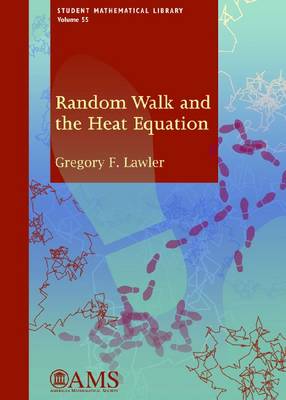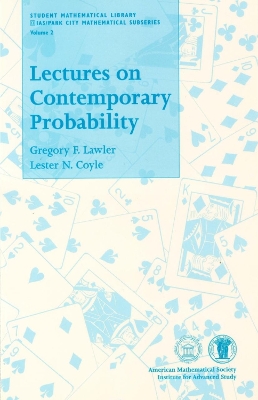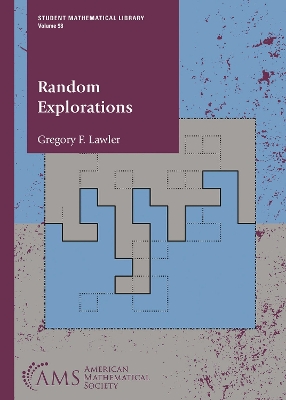Student Mathematical Library
3 total works
The heat equation can be derived by averaging over a very large number of particles. Traditionally, the resulting PDE is studied as a deterministic equation, an approach that has brought many significant results and a deep understanding of the equation and its solutions. By studying the heat equation by considering the individual random particles, however, one gains further intuition into the problem. While this is now standard for many researchers, this approach is generally not presented at the undergraduate level. In this book, Lawler introduces the heat equation and the closely related notion of harmonic functions from a probabilistic perspective. The theme of the first two chapters of the book is the relationship between random walks and the heat equation. The first chapter discusses the discrete case, random walk and the heat equation on the integer lattice; and the second chapter discusses the continuous case, Brownian motion and the usual heat equation. Relationships are shown between the two. For example, solving the heat equation in the discrete setting becomes a problem of diagonalization of symmetric matrices, which becomes a problem in Fourier series in the continuous case. Random walk and Brownian motion are introduced and developed from first principles. The latter two chapters discuss different topics: martingales and fractal dimension, with the chapters tied together by one example, a random Cantor set. The idea of this book is to merge probabilistic and deterministic approaches to heat flow. It is also intended as a bridge from undergraduate analysis to graduate and research perspectives. The book is suitable for advanced undergraduates, particularly those considering graduate work in mathematics or related areas.
Lectures on Contemporary Probability
by Gregory F. Lawler and Lester N. Coyle
Published 1 March 2007
This volume is based on classes in probability for advanced undergraduates held at the IAS/Park City Mathematics Institute (Utah). It is derived from both lectures (Chapters 1-10) and computer simulations (Chapters 11-13) that were held during the program. The material is coordinated so that some of the major computer simulations relate to topics covered in the first ten chapters. The goal is to present topics that are accessible to advanced undergraduates, yet are areas of current research in probability. The combination of the lucid yet informal style of the lectures and the hands-on nature of the simulations allows readers to become familiar with some interesting and active areas of probability. The first four chapters discuss random walks and the continuous limit of random walks: Brownian motion.Chapters 5 and 6 consider the fascinating mathematics of card shuffles, including the notions of random walks on a symmetric group and the general idea of random permutations. Chapters 7 and 8 discuss Markov chains, beginning with a standard introduction to the theory. Chapter 8 addresses the recent important application of Markov chains to simulations of random systems on large finite sets: Markov Chain Monte Carlo. Random walks and electrical networks are covered in Chapter 9. Uniform spanning trees, as connected to probability and random walks, are treated in Chapter 10. The final three chapters of the book present simulations. Chapter 11 discusses simulations for random walks.Chapter 12 covers simulation topics such as sampling from continuous distributions, random permutations, and estimating the number of matrices with certain conditions using Markov Chain Monte Carlo. Chapter 13 presents simulations of stochastic differential equations for applications in finance. (The simulations do not require one particular piece of software. They can be done in symbolic computation packages or via programming languages such as C.) The volume concludes with a number of problems ranging from routine to very difficult. Of particular note are problems that are typical of simulation problems given to students by the authors when teaching undergraduate probability.
The title Random Explorations has two meanings. First, a few topics of advanced probability are deeply explored. Second, there is a recurring theme of analyzing a random object by exploring a random path.
This book is an outgrowth of lectures by the author in the University of Chicago Research Experiences for Undergraduate (REU) program in 2020. The idea of the course was to expose advanced undergraduates to ideas in probability research.
The book begins with Markov chains with an emphasis on transient or killed chains that have finite Green's function. This function, and its inverse called the Laplacian, is discussed next to relate two objects that arise in statistical physics, the loop-erased random walk (LERW) and the uniform spanning tree (UST). A modern approach is used including loop measures and soups. Understanding these approaches as the system size goes to infinity requires a deep understanding of the simple random walk so that is studied next, followed by a look at the infinite LERW and UST. Another model, the Gaussian free field (GFF), is introduced and related to loop measure. The emphasis in the book is on discrete models, but the final chapter gives an introduction to the continuous objects: Brownian motion, Brownian loop measures and soups, Schramm-Loewner evolution (SLE), and the continuous Gaussian free field. A number of exercises scattered throughout the text will help a serious reader gain better understanding of the material.
This book is an outgrowth of lectures by the author in the University of Chicago Research Experiences for Undergraduate (REU) program in 2020. The idea of the course was to expose advanced undergraduates to ideas in probability research.
The book begins with Markov chains with an emphasis on transient or killed chains that have finite Green's function. This function, and its inverse called the Laplacian, is discussed next to relate two objects that arise in statistical physics, the loop-erased random walk (LERW) and the uniform spanning tree (UST). A modern approach is used including loop measures and soups. Understanding these approaches as the system size goes to infinity requires a deep understanding of the simple random walk so that is studied next, followed by a look at the infinite LERW and UST. Another model, the Gaussian free field (GFF), is introduced and related to loop measure. The emphasis in the book is on discrete models, but the final chapter gives an introduction to the continuous objects: Brownian motion, Brownian loop measures and soups, Schramm-Loewner evolution (SLE), and the continuous Gaussian free field. A number of exercises scattered throughout the text will help a serious reader gain better understanding of the material.


